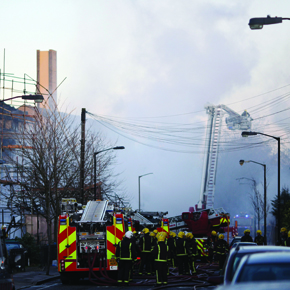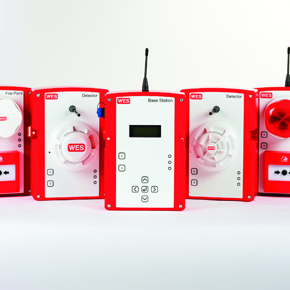
How EN54-compliant wireless alarm systems minimise risks on construction sites
Paul Henson, sales and marketing director at Ramtech Electronics, looks at why having an EN54-compliant wireless fire alarm system provides the best way of minimising risks on a construction site…
Each year there are hundreds of fires on construction sites, potentially putting the lives of workers and members of the public at risk. Ensuring that workers and assets are protected therefore requires careful consideration of a number of factors.
 Size of the project, proximity of nearby buildings, number of storeys and type and amount of flammable materials present, plus other factors, all need to be taken into account. Although the health and safety record of the construction industry has improved significantly over the last few years, the risk from fire remains high and ever present.
Size of the project, proximity of nearby buildings, number of storeys and type and amount of flammable materials present, plus other factors, all need to be taken into account. Although the health and safety record of the construction industry has improved significantly over the last few years, the risk from fire remains high and ever present.
In fact, the dangers from fire are multiplied because it can spread rapidly to adjacent buildings putting members of the public at risk. Legislators are well aware of the dangers, and fire safety in the UK’s construction industry is covered by a number of laws, guidelines and codes of practice, including:
- The Regulatory Reform (Fire Safety) Order (2005)
- The Construction (Design and Management) Regulations
- HSE Fire Safety Guidelines for Construction Sites (HSG168)
- The Fire Protection Association Joint Code of Practice
- BS5839-1 – Fire detection and fire alarm systems for buildings.
- Code of practice for design, installation, commissioning and maintenance of systems in non-domestic premises
- The Structural Timber Association’s 16 Steps to Timber Frame Construction
All of these set out fire safety requirements in relation to their particular focus and each specifies that an appropriate fire alarm system must be used. These guidelines form a comprehensive set of best practice indicators for the use and installation of fire safety systems in the construction industry.
Alongside this legislation, the Construction Products Regulation, which came into force in 2013, says that fire alarm products sold in the European Union must be tested and independently certified against Harmonised European standards where these exist.
In the case of fire detection and fire alarm products, that standard is EN 54 Fire detection and fire alarm systems. Effectively, the law and best practice guidelines require that construction sites are protected with a suitable fire alarm system and EN 54 is the standard against which fire alarm systems should be measured.
More recently, the The Joint Code of Practice on the protection from Fire on Construction Sites and Buildings Undergoing Renovation (JCOP) has been updated (October 2015) and is now available in its 9th edition.
This latest version applies to activities carried out prior to and during the procurement, construction and design process. JCOP is an important document for construction professionals as it is commonly referred to in insurance contracts because it is recognised as best practice.
The objective of JCOP is to prevent fires on construction sites and it includes some useful guidance on how to do this. For instance, the most significant update to the 9th edition reinforces the need for construction site fire alarm systems to meet the requirements of EN 54.
Paragraph 13.8 lays this out: Components of automatic fire detection and alarm systems should be marked as complying with EN 54.
In updating JCOP, the FPA and the insurance industry has made it much easier to specify construction site fire alarms that are up to the same high standard as other safety critical construction site products such as ladders and scaffold boards.
JCOP caries considerable influence as it was developed by the Technical Division of the Fire Protection Association (FPA) and experts from the insurance industry who reported to the RISCAuthority Risk Control Steering Group.
Technological solution
The key to minimising damage and injury from fire is bringing all these pieces of legislation together into a comprehensive fire alarm system. There are two basic routes – either a wireless or wired system.
An EN 54 compliant wireless fire alarm system offers significant installation benefits because it requires no hard wiring – making it easy to install and reposition the units.
There is the added advantage that it provides site-wide protection because the wireless signal is capable of passing through all solid materials typically found on a building site.
Construction professionals are realising the benefits of installing a fully EN 54 compliant fire alarm system.
Fire can cause immense damage to assets that are costly to rectify, not to mention smoke and flames being an immediate danger to workers and people in nearby buildings. Fire safety in completed buildings is regarded with the utmost importance – regular fire drills and testing of equipment – and so it is common sense that it should also be treated in the same way for a building under construction.
The need to protect people from harm during this phase should be as much of a priority as it is for those that will ultimately live and work within the completed building.
Read more in the December issue of PSB Magazine
Latest news

22nd November 2024
Insight Data: Using Marketing Data to Build a Successful Business in 2025
Alex Tremlett, Insight Data’s Commercial Director, discusses the challenges for construction firms in 2025 and shares six strategies for success…
Posted in Articles, Building Industry News, Building Services, Information Technology, news, Research & Materials Testing
22nd November 2024
Purplex: A tough Budget, but opportunity still knocks
Incoming governments, especially those with significant mandates, inevitably come into power on a tidal wave of optimism coupled with hope that ‘Things can only get better’. Andrew Scott, MD of construction-focused, full-service agency Purplex, talks…
Posted in Articles, Building Industry News, Building Services, Information Technology, news, Posts, Research & Materials Testing
22nd November 2024
Pop Up Power Supplies Gets Arty in Yorkshire
Pop Up Power Supplies has installed 13 new electricity units at The Hepworth Wakefield – read more in this article…
Posted in Articles, Building Industry News, Building Products & Structures, Building Services, Case Studies, Civil Engineering, Facility Management & Building Services, Garden, Hard Landscaping & Walkways, Landscaping, Posts, Restoration & Refurbishment, Retrofit & Renovation
22nd November 2024
OPT Services Revolutionises Fibre Cable Capping with Eco-Friendly Innovation
UK-based OPT Services has unveiled SlimLine™ Capping, a groundbreaking fibre cable protection solution that promises to deliver significant environmental and installation advantages to the fibre optic industry.
Posted in Articles, Building Industry News, Building Products & Structures, Building Services, Facility Management & Building Services, Information Technology, Innovations & New Products, Sustainability & Energy Efficiency
 Sign up:
Sign up: